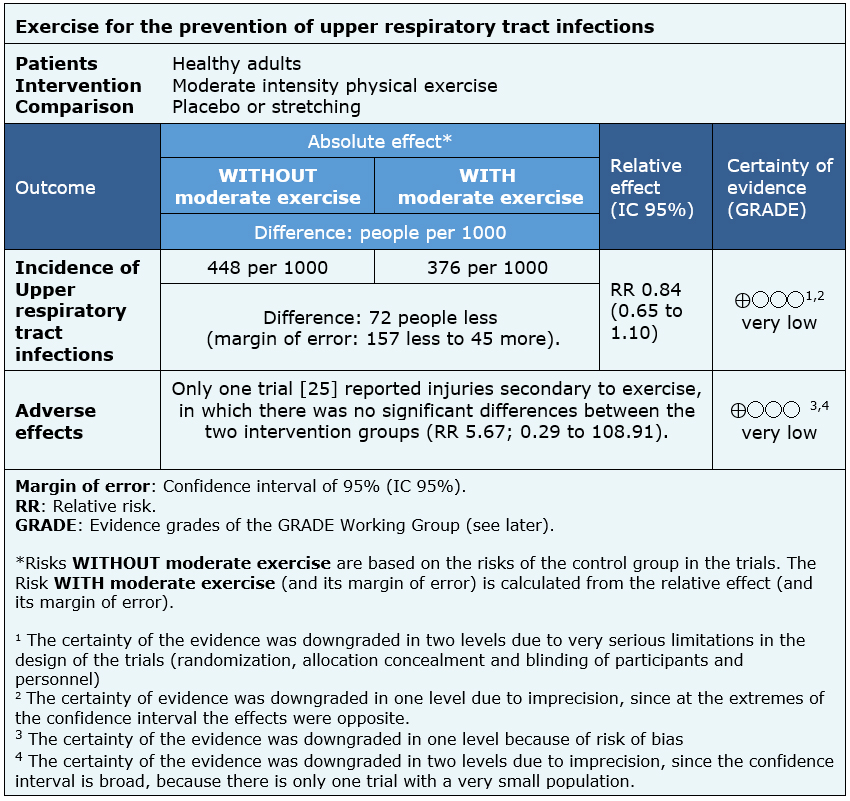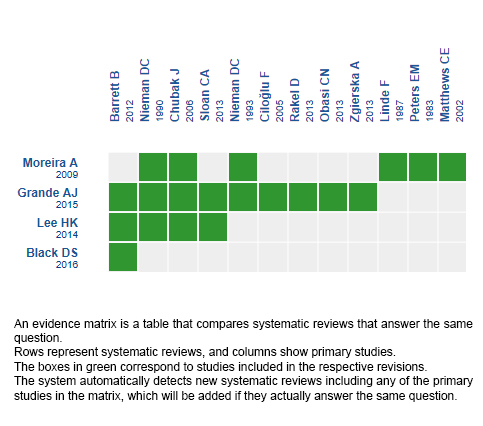Epistemonikos summaries
← vista completaPublished on July 20, 2018 | http://doi.org/10.5867/medwave.2018.04.7225
Is the exercise effective for the prevention of upper respiratory tract infections?
¿Es útil el ejercicio en la prevención de infecciones respiratorias altas?
Abstract
INTRODUCTION Upper respiratory tract infections are one of the main causes of medical consultation in the world. Considering the lack of specific treatment, prevention becomes essential. It has been postulated that exercise could have a preventive role, but its clinical effectiveness remains a topic of discussion.
METHODS To answer this question we used Epistemonikos, the largest database of systematic reviews in health, which is maintained by screening multiple information sources, including MEDLINE, EMBASE, Cochrane, among others. We extracted data from the systematic reviews, reanalyzed data of primary studies, conducted a meta-analysis and generated a summary of findings table using the GRADE approach.
RESULTS AND CONCLUSIONS We identified four systematic reviews including fourteen studies overall, of which six were randomized trials. We concluded it is not clear whether exercise of moderate intensity prevents or not upper respiratory infections, because the certainty of the evidence is very low.
Problem
Upper respiratory infections have a high prevalence, and impose important financial burden to the systems through costs derived from frequent consultations and absenteeism. It is estimated that each year a child suffers about five upper respiratory infections, and an adult between two and three [1].
It has been suggested that the relationship between exercise and upper respiratory infections follows a “type j” curve, where moderate and regular exercise would improve the ability to resist infections and reduce the number of symptomatic days of those who suffer them [2]. This effect would be mediated by varying concentration of different cells or cell products that affect immune system, especially immunoglobulin A and natural killer cells [3]. On the other hand, high intensity or chronic exercise would decrease the ability to resist infections, which could constitute a potential risk.
The role of regular physical activity in preventing diseases, such as colds or other upper respiratory diseases, is not well defined. The objective of this summary is to evaluate the existing evidence, in order to improve our understanding of this problem.
Methods
To answer the question, we used Epistemonikos, the largest database of systematic reviews in health, which is maintained by screening multiple information sources, including MEDLINE, EMBASE, Cochrane, among others, to identify systematic reviews and their included primary studies. We extracted data from the identified reviews and reanalyzed data from primary studies included in those reviews. With this information, we generated a structured summary denominated FRISBEE (Friendly Summary of Body of Evidence using Epistemonikos) using a pre-established format, which includes key messages, a summary of the body of evidence (presented as an evidence matrix in Epistemonikos), meta-analysis of the total of studies when it is possible, a summary of findings table following the GRADE approach and a table of other considerations for decision-making.
|
Key messages
|
About the body of evidence for this question
|
What is the evidence. |
We found four systematic reviews [4],[5],[6],[7] including 14 primary studies (reported in 18 references) [8],[9],[10],[11],[12],[13],[14],[15],[16],[17], |
|
What types of patients were included* |
Four trials included only women, between 25 and 75 years, sedentary (less than 60 minutes per week of moderate or vigorous physical activity), without allergies, without using medications and with no previous illnesses [9],[10],[11],[14]. Two trials included adults of either sex [8],[25], between 67 to 85 years [25] and 56 years on average [8], sedentary, non-smokers, not using medications that affect the immune system. All trials excluded people vaccinated against influenza, or with chronic diseases, history of cardiovascular disease or tobacco consumption in the last two years. No trial reported the period of the year in which the intervention was carried out. |
|
What types of interventions were included* |
Five trials evaluated the effect of moderate intensity physical activity, from 30 to 45 minutes, during five days per week, with an increase of 60% to 75% of their maximum heart rate. Among the exercises performed, all of the trials included rapid treadmill walking and one trial used a stationary bicycle [10]. In all the trials heart rate and distance traveled were monitored, and supervised by an instructor. In two trials, the control group performed stretching sessions during the period of the intervention [25],[10] and in three trials heart rate was recorded during their daily activities [9],[14],[11]. |
|
What types of outcomes |
The trials measured several outcomes, which were grouped by the systematic reviews in the following way:
In two trials the average follow-up was 12 weeks [25],[11], in two trials the follow-up was 15 weeks [9],[14], one trial had a follow-up of 12 months [10] and one trial had a follow-up of only 8 weeks [8]. |
* The information about primary studies is extracted from the systematic reviews identified, unless otherwise specified.
Summary of Findings
Information about the effects of exercise for the prevention of upper respiratory tract infections is based on five randomized trials involving 311 participants in total [8],[9],[10],[14],[25]. It was not possible to incorporate the information of one trial [11], because it did not have data that could be incorporated into the meta-analysis.
Five trials reported the effect of exercise on the incidence of upper respiratory tract infections (311 participants) and only one trial [25] measured adverse effects of exercise (injuries associated with the practice) (30 participants).
The summary of findings is as follows:
- It is not clear whether moderate intensity physical exercise decreases the risk of developing upper respiratory infections because the certainty of the evidence is very low.
- It is not clear whether there are adverse effects associated with moderate intensity physical exercise in the prevention of upper respiratory infections because the certainty of the evidence is very low.

| Follow the link to access the interactive version of this table (Interactive Summary of Findings - iSoF) |

Other considerations for decision-making
|
To whom this evidence does and does not apply |
|
| About the outcomes included in this summary |
|
| Balance between benefits and risks, and certainty of the evidence |
|
| Resource considerations |
|
| What would patients and their doctors think about this intervention |
|
|
Differences between this summary and other sources |
|
| Could this evidence change in the future? |
|
How we conducted this summary
Using automated and collaborative means, we compiled all the relevant evidence for the question of interest and we present it as a matrix of evidence.

Follow the link to access the interactive version: Exercise for prevention of upper respiratory tract infections
Notes
The upper portion of the matrix of evidence will display a warning of “new evidence” if new systematic reviews are published after the publication of this summary. Even though the project considers the periodical update of these summaries, users are invited to comment in Medwave or to contact the authors through email if they find new evidence and the summary should be updated earlier.
After creating an account in Epistemonikos, users will be able to save the matrixes and to receive automated notifications any time new evidence potentially relevant for the question appears.
This article is part of the Epistemonikos Evidence Synthesis project. It is elaborated with a pre-established methodology, following rigorous methodological standards and internal peer review process. Each of these articles corresponds to a summary, denominated FRISBEE (Friendly Summary of Body of Evidence using Epistemonikos), whose main objective is to synthesize the body of evidence for a specific question, with a friendly format to clinical professionals. Its main resources are based on the evidence matrix of Epistemonikos and analysis of results using GRADE methodology. Further details of the methods for developing this FRISBEE are described here (http://dx.doi.org/10.5867/medwave.2014.06.5997)
Epistemonikos foundation is a non-for-profit organization aiming to bring information closer to health decision-makers with technology. Its main development is Epistemonikos database (www.epistemonikos.org).
Potential conflicts of interest
The authors do not have relevant interests to declare.

